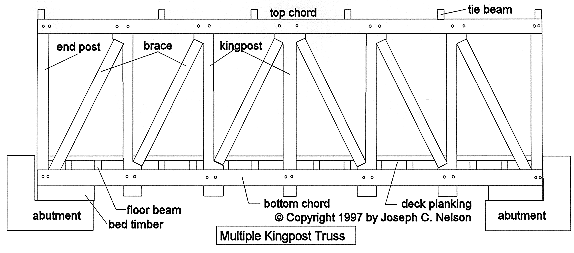
The Multiple Kingpost Truss¹
The multiple-kingpost truss is an excellent example of the use of a "series of combined triangles" to create a load-bearing span. The tops of the vertical members, or kingposts, are joined to the upper chord by mortise and tenon. The bases of the kingposts are joined to the lower chord by an interlocking notch or lap. The braces are set into steps cut into the kingposts without mortise, tenon or tongue. The assembly of upper and lower chords, kingposts and braces form a rigid truss that resists deformation. The weight of the bridge and its users tends to settle the truss, compressing the braces and upper chord while stretching the lower chord and the kingposts supporting it.
Vermont's multiple-kingpost bridges average sixty-seven feet in length. They range in length from James Tasker's forty-six-foot Stoughton Bridge to the Union Village Bridge, which stretches a whopping 112 feet. The kingposts typically measure six by eight inches cut from a six-by-sixteen-inch timber to provide steps for the braces. The braces typically measure four by six inches.

Footnotes:
- Text and illustration ©1997, Joseph C. Nelson
